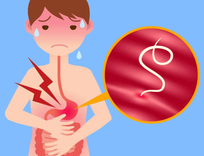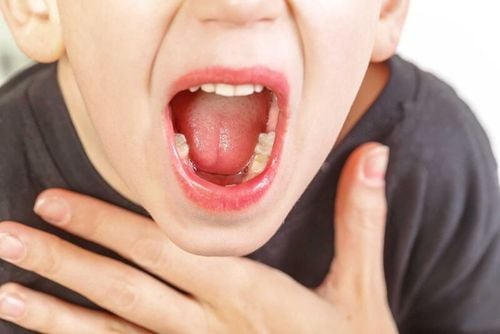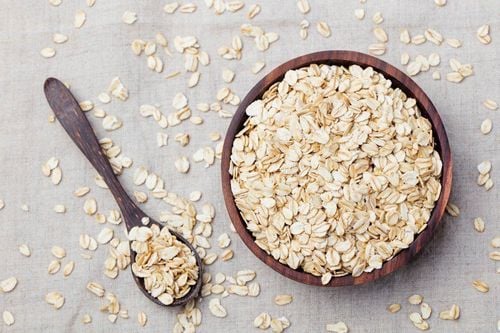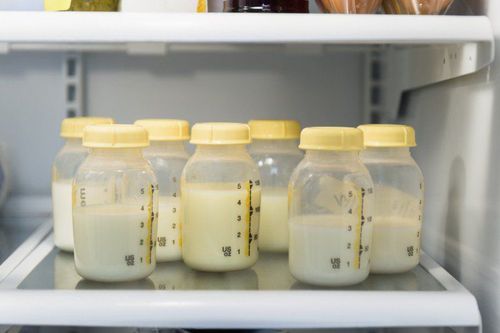The first stage when children start to eat solid foods may affect the digestive system thereby changing the child's bowel habits. When solids are introduced, your baby's poop will change from loose stools to more viscous and solid stools, eventually forming a mold and similar in appearance to adult poop. The frequency of bowel movements will also change. This makes it easy for parents to misunderstand that the child is constipated when in fact it is not. Monitoring eating habits and stool properties to quickly recognize the signs of constipation in weaning babies is something that parents should do.
1. What are the signs that a baby is constipated?
A healthy baby can defecate as often as once every few days to 6 times a day. As a change in diet begins with solids, the baby's poop will also change, so the baby may pass more or less and the stool itself may change to resemble adult poop. Some babies may become constipated when their intestines are not yet adapted to handling new foods. It is important for parents to understand that every baby is different.
If your child suddenly cries and tries to pass a small amount of hard, dry stools and he poops less often than usual, he or she is most likely constipated.
Your baby's poop can vary in color and consistency from day to day. As babies are weaned and begin to eat solid foods with more solid foods, their stools will change in color and smell, becoming thicker, darker, and more fishy. You will notice that your baby's poop will change depending on the foods you have given him. These changes will again be observed as the child grows up, entering toddlerhood and then preschool, parents may see further changes in bowel frequency and The nature of the stool, always depends on what the child is eating.
Here are some signs of constipation in babies on solid foods that parents should keep in mind:
Children push hard and blush for more than 10 minutes when defecating
Children with constipation often have many difficulties in defecation . If your baby defecates with a flushed face and stools last for more than 10 minutes, chances are he's constipated.
Crying and pain when trying to defecate
The stools of constipated children are often small and hard, so it can be painful to have a bowel movement, especially if the child hasn't had a bowel movement in several days. Constipated weaning babies may also experience abdominal pain due to intestinal spasms when constipated.
Hard, dry and round stools
Children with constipation often pass stools that are small, round, and dry. This is because food moves slowly and stays longer in the large intestine, where water is reabsorbed into the body, creating stools that are harder than usual.

Some other symptoms suggest constipation in infants, such as:
- Sometimes blood in diapers due to anal fissures. This is a possible consequence of a baby's stools being too hard and dry.
- Fewer bowel movements and stools than usual.
- Loss of appetite.
- Hard or palpable stools.
- Changes in behavior, such as being more irritable.
2. Why are babies easily constipated?
During the first 6 months of a baby's life, they get used to breast milk or formula. And in these 6 months, the baby's digestive system has developed and is more complete to prepare to start weaning. However, your baby's digestive system won't produce enough enzymes to digest starch until about 6 months. Over a period of 6 to 9 months, the production of bile salts and lipase (important for fat digestion) will reach the required maturity. So, keep in mind that the milestone for starting solids is a guideline to protect your baby's health and ensure proper development.
When starting solids, it may take some time for the digestive system to adapt to this new way of eating. And during this adjustment period, parents often find their child constipated and having difficulty having a bowel movement. Also, the first foods that adults give babies often include low-fiber varieties, like baby rice or baby cereal. We know that a lack of fiber in the diet can cause constipation. The same is true for children's bodies.
3. What should parents do when recognizing signs of constipation in children eating solids?
Some effective home remedies that parents can apply to deal with constipation in babies on solids include:
Fruits
Make sure your baby is eating a variety of fruits and various vegetables, such as apples, apricots, pears and grapes. They can be eaten pureed or chopped and eaten as a side dish.
Green vegetables
Similar to adults, children at the age of weaning should eat a variety of green vegetables. However, it is not necessary to feed the baby with vegetables with the skin on, as this may provide too much fiber for his small stomach and will keep him full for a long time.
Water
Keep your baby's body hydrated. Give your baby some water to drink between feeds, but don't dilute formula if your baby is bottle-fed.
Children should not be given too much baby rice
It is thought that baby rice can make constipation worse, so limit baby rice as much as possible while your child is constipated.
Diluted juice
Some babies may get better pain when drinking diluted fruit juice such as orange juice diluted with water. After overcoming constipation, children should still be given priority to supplement with filtered water. Do not choose to buy canned fruit juices because these products contain a lot of sugar, which is not suitable for children's digestive system.
Baby massage
Can relieve constipation and put your baby at ease. Gently move your baby's legs in a cycling motion to help hard stools move along his intestines. You can use your hands to massage the baby's belly in a clockwise circular motion from right to left for the same effect.

In short, constipation is a condition that many children suffer from, especially during the period when children start eating solid foods. Therefore, parents need to know the symptoms and have an appropriate nutritional adjustment. If long-term constipation makes the child anorexic and uncomfortable, it is necessary to take the child to the medical center for examination and treatment, to avoid dangerous complications that may occur.
In the case of children with prolonged anorexia, malabsorption, and growth retardation, parents should supplement children with supportive products containing lysine, essential micro-minerals and vitamins such as zinc, chromium, selenium, and B vitamins. help meet the nutritional needs of children. At the same time, these essential vitamins also support digestion, enhance nutrient absorption, help improve anorexia, and help children eat well.
Parents can simultaneously apply dietary supplements and functional foods derived from nature for easy absorption. The most important thing is that improving your baby's symptoms often takes a long time. Combining many types of functional foods at the same time or changing many types in a short time can make the baby's digestive system unable to adapt and completely not good.
Therefore, parents must be really patient with their children and regularly visit the website vimec.com to update useful baby care information.













